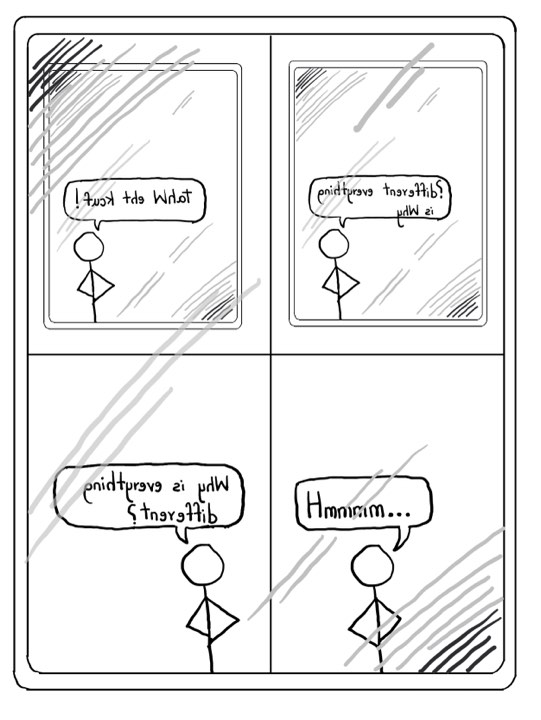Entry point: the Reversal assignment
5. Assigning the reversal
4. Reversing the assignment
3. Assigning the assignment
2. Reversing the reversal
1. Uno reverse
Below is the comic I made:

Entry point: the Reversal assignment
5. Assigning the reversal
4. Reversing the assignment
3. Assigning the assignment
2. Reversing the reversal
1. Uno reverse
Below is the comic I made:

I feel this section of the book is rather conflicting than our previous readings. In the discussion of being right versus being effective, the author states that “being effective means being right only at the end.” Does this not mean that being right equates to being effective? If being right “means being right all the time”, shouldn’t that be the most effective method? Whether we are being right or we are being effective, our end goal is to be right.
The author refutes this argument by suggesting that an obsession with being right stifles creativity, which leads him to advocate for “delaying judgement.” However, the concept itself seems fundamentally flawed. If we delay judgement on whether an idea is right, we either perform a bunch of unnecessary steps until we eventually conclude that the idea was right to begin with, imply that the idea is wrong, or eventually becomes wrong. However, should we not also delay the judgement that an idea is wrong? In the book’s example, we could have created a path from C to B (which we are perfectly capable of doing) thus dismissing the idea that C is the incorrect path.
Another issue with delaying judgement is that we do not know when, or if, we will arrive at the final answer. Consider looking up the meaning of a word in a dictionary, then having to look up the meaning of every word within the definition of the original word. One of two things would happen: (1) you would eventually be stuck in a loop of a subset of all the words in the dictionary, ending up with only a vague idea of the original word’s meaning, or (2) you would have to go through every single word in the dictionary to understand the meaning of one word. In such a case, does the end justify the means?
The one line that resonates with me the most from this reading, especially in the context of this class, is the inevitable gap between what we intend to do and what we end up doing. More often than not, I find myself unsatisfied with the final product of the Making assignments because, in my head, I had envisioned something quite different. This dissatisfaction does not stem from a flaw in the concept itself but rather from my lack of editing skills. Sometimes, it is also difficult to convey the exact meaning of what I’m trying to depict since often, the audience have their own interpretation of the work. Even when I attempt to explain my intentions, my efforts can be inadequate, and thus, the meaning is lost in translation. This is also true when reflecting on the readings. I wonder how much I of what I am trying to say am I able to explain in the responses, and how much you, the one reading it, are able to understand.
It was a very calming and relaxed session. I was intrigued by his concept of choreography, that it does not have to be about extravagant movements but can also be as simple as two strangers swaying together in unison. His concepts were very broad and unconventional, yet at the same time, very realistic and focused. I think my favorite part about his presentation was when he talked about dying. He mentioned that where there is death, there is life (bacteria in dead bodies). It is such a simple yet such an overlooked concept, and I am thankful he reminded me of it.
After we decided on the theme of “incompleteness”, we listed some incomplete things:
From this list, I decide to go with 1. You can find the result here: https://rb5213.github.io/
Conceptually, I find a lot of similarities between her and Mariana. One thing I noticed during the presentation of Merche’s work is that she makes certain hand movements (like an 8) more frequently. This reflects to how the mind frequently manages to carve patterns out of randomness, even for something as random as improvisation.
Why did you come to Berlin?
Why was it one of your choices?
Why did you want to have such an experience?
Why is such a revelation necessary?
Why do you ponder over these striking questions?
Why can you not sleep without having such thoughts?
Why do you have difficulty falling asleep?
I created a binaural beat by combining two mono tracks of frequencies 220 Hz and 224 Hz for the left ear and right ear respectively. I mixed the two tracks and exported the mp3 file. Then I sourced some rain, wind, and wind chimes audios online and merged these with the binaural beat to make the final soundtrack.
Reading the section “Code Communication” made me recall a thought process I often pondered. It is a simple question: “Why does one plus one equal two?” and not some obscure set of symbols? What does obscurity mean in the first place? We associate “1” with “one” because that is the predefined convention established by mathematicians. If different symbols were used, as long as there was a consensus on their meaning, the fundamental concepts wouldn’t change. This general consensus is what forms the basis of code communication that the book refers to.
Even in the title of this very blog, you might have been irked by the simultaneous use of a comma following a question mark. Since it deviates from the established norm, we have difficulty accepting it. Sure, one plus one equals two but that is only in the decimal number system. In binary, one plus one equals ten. So which is it? Two or ten? Both. “10” represents the same quantity that “2”. Because these number systems have different consensus, they have different codes to communicate by. And do not get me started on languages and their complexities. Perhaps, in a hypothetical alternate timeline, we have a simple system. Perhaps there, one plus one equals three.
When attempting the exercise of making an L from a square with 2 cuts in class, I was fixated on turning the larger leftover cutout into the required shape. However, the first solution that was later presented was not restricted by this limitation I had assumed. Instead, by using a single straight cut through the middle and arranging one of the halves vertically over the other, which remains horizontal, an L shape could still be achieved. This simple solution showed me what lateral thinking is, as mentioned in the book: a process of “restructuring, escape and the provocation of new patterns.” The passage also provides a revision of the in-class discussion about the differences between “Natural Search for Alternatives” versus “Lateral Search”. In both the book and the discussion, an idea that is brought up is the possibility of different approaches to a problem or task. It reminded of Otis Sandjso’s process of improvisation and how he mentioned that the songs he makes are layers upon layers of different practice sessions, building one over the other but never completely replacing any one of them. It makes me wonder how much of his improvisation relies on lateral thinking and in what capacity is the former concept dependent on the other.
Attached is the documentation for the 30 Circles making activity and the final design.

I concur with Kermit’s “conspiracy of craziness” and the subsequent idea of the freedom of thought. To have the audacity to think beyond the conventional is the craziness that Kermit refers to. Had Galileo not advocated for the heliocentric model proposed by Copernicus against the predominant geocentrism of the Catholic Church, would man have ever stepped foot on the distant floating rock that changes every day? Would Rover be looking for signs of life on the dusty red planet? “Suspending disbelief” is where creativity originates. Add to this, the freedom of thought that entertains the premise that what seems impossible is eventually achievable, and we foster creativity. Just as the telescope magnifies the image in the sky, we see a flag standing atop the Moon’s surface, and a Tesla Roadster floats in space while we think of growing plants in Mars.